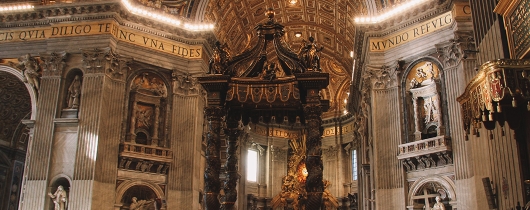The Church | La Iglesia

Dedication of the Basilicas of St. Peter and St. Paul
1 Maccabees 2:15-29; Luke 19:39-41
It is sometimes said that “church is not a building.” True enough, but that doesn’t mean that our churches and other sacred spaces don’t matter to us. Over the years we have witnessed the anguish many people feel when their churches are closed. We mourn with those who have seen their churches vandalized or burned because of religious persecution.
Our churches are far more than buildings of brick, stone, wood, and marble. They are repositories of sacred memories, family histories, and profound meaning. Celebrating the dedication of churches like the two basilicas we remember today is a recognition of their importance in the life of the wider body of Christ.
Jesus wept over Jerusalem when he envisioned its destruction, and especially of the temple, the center of the faith life of his people. When the temple was destroyed in 70 CE following a long Roman siege, it meant a profound loss of meaning, identity, and sense of God’s presence with his people.
Roughly 200 years earlier, Mattathias and his sons had a similar confrontation with their Greek overlords, rejecting their campaign of religious persecution and forced cultural assimilation. The catalyst for their revolt was the placement of a pagan idol on the altar of holocaust in the Jerusalem temple. The sacred had been profaned.
The basilicas of St. Peter and St. Paul were both originally built in the 4th century over the tombs of the saints they honor. St. Peter’s was rebuilt in the 17th century and St. Paul’s in the 19th. They remain centers of Catholic identity, places of pilgrimage, and engines of evangelization. We give thanks for their continued vitality. - jc
----------------------------------------------------------------------------------------
Dedicación de las basílicas de San Pedro y San Pablo
1 Macabeos 2:15-29; Lucas 19:39-41
A veces se dice que "la iglesia no es un edificio". Es cierto, pero eso no significa que nuestras iglesias y otros espacios sagrados no nos importen. A lo largo de los años hemos sido testigos de la angustia que sienten muchas personas cuando se cierran sus iglesias. Lloramos con quienes han visto sus iglesias vandalizadas o quemadas a causa de la persecución religiosa.
Nuestras iglesias son mucho más que edificios de ladrillo, piedra, madera y mármol. Son depósitos de recuerdos sagrados, historias familiares y un profundo significado. Celebrar la dedicación de iglesias como las dos basílicas que recordamos hoy es un reconocimiento de su importancia en la vida del cuerpo de Cristo en general.
Jesús lloró por Jerusalén cuando previó su destrucción, y especialmente la del templo, centro de la vida de fe de su pueblo. La destrucción del templo en el año 70, tras un largo asedio romano, supuso una profunda pérdida de significado, identidad y sentido de la presencia de Dios con su pueblo.
Unos 200 años antes, Matatías y sus hijos tuvieron un enfrentamiento similar con sus señores griegos, rechazando su campaña de persecución religiosa y asimilación cultural forzada. El catalizador de su revuelta fue la colocación de un ídolo pagano en el altar del holocausto del templo de Jerusalén. Lo sagrado había sido profanado.
Las basílicas de San Pedro y San Pablo se construyeron originalmente en el siglo IV sobre las tumbas de los santos a los que honran. La de San Pedro fue reconstruida en el siglo XVII y la de San Pablo en el XIX. Siguen siendo centros de identidad católica, lugares de peregrinación y motores de evangelización. Damos gracias por su continua vitalidad. - jc




